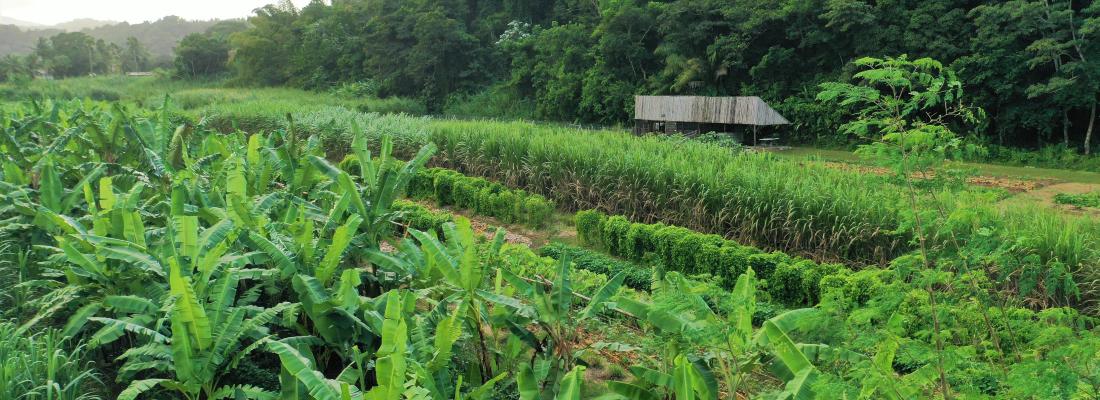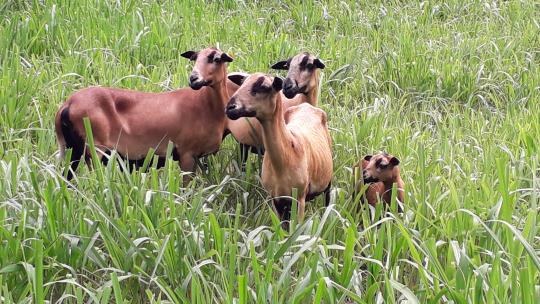Agroecology Reading time 5 min
Microfarms in Guadeloupe: the agroecological transition has begun
Published on 14 September 2021

With a hot and humid tropical climate, agriculture in Guadeloupe is dominated by two major export crops, i.e. sugarcane and banana, far superior in surface area due to formal large-scale farming operations and the use of paid labour. At the opposite end of the scale, small holdings (4.2 ha in 2016 – source: Agreste) using multiple-crop and mixed-livestock farming are numerically more significant (83% of farms in 2013 – source: Agreste), but are sometimes informal and operate primarily with family labour.
51,583 ha of utilised agricultural area in this French département (31% of its land area) including 0.9% used for organic farming
71,538 ha of wooded surface area (44% of its land area)
6,647 farms
11,800 people in permanent employment (3% of the population)
Leading production sectors in tonnes: sugarcane - 631,500; banana fruit - 33,500; melon - 5492
(Source: Agreste)
As early as 2014, INRA, which has since become INRAE, signed a framework agreement with the Guadeloupe Region setting out the broad lines for agricultural research in Guadeloupe.
In October 2020, the Guadeloupe Region approved the Regional Strategic Plan for an Agroecological Land Transition based on three major work areas, i.e. providing support to economically viable agroecological systems; allowing agroecological systems access to land; ensuring dissemination, training and innovation to promote an agroecological transition.
On INRAE's Duclos Domain, two microfarms host long-term research projects based on agroecology for small family agriculture. "Agroecology," explains Jean-Marc Blazy, head of the EXPLORER project, "involves designing production systems based on the functions ecosystems can offer. It strengthens them while, at the same time, aiming to decrease pressures on the environment and protect natural resources."
With a view to move towards greater food autonomy and a smaller climate footprint, the first microfarm has given priority to plant-animal integration, while the second focuses on the bioeconomy. A guided tour follows.
AgroEcoDiv, a model modern agroecological farm
Since 2017, about 30 researchers, hailing from no less than 20 scientific disciplines, have been developing a pilot farm. There you can find sugarcane alongside bananas, and tomatoes and peas having a field day while cattle, sheep, and goats cavort in the field next to the pig facility. All this is flourishing in a closed loop since byproducts and unsold stock serve as feed for the animals, whose manure fertilises the fields.
This miniature farming operation, as its manager Audrey Fanchone describes it, has been built on farmers' knowledge and practices so as to move towards a fully agroecological farm over the next five years. It is managed by a core group of volunteer farmers and brings together a wide range of stakeholders from the world of research, civil society, the association sector and local government.
A true forum for co-designing, creating reference materials and demonstrating agroecological practices, this farm is both a discussion platform for those interested in implementing new work methods and a trial site where farmers test various practices gained from field experience and scientific support in order to improve their practices' agricultural, economic and environmental performances.
In April 2021, nearly 350 madère (or taro) seedlings were planted with the help of a dozen technical agents and volunteers. At the same time, the farm is home to 80 naked neck roosters to keep the farm's livestock workshop well stocked.
In July, in order to test the agroecological innovations trialled at the farm under real-life conditions, some 3000 sq. m of black-eye peas (or niébé) were planted in the Nord Grande Terre zone.
The latest news about the project, publications, events and other discussions… AgroEcoDiv now offers a newsletter for the project's consortium and its partners.
The research issues discussed in the newsletter are the focus of the AgroEcoDiv project - Co-designing high-performance and resilient farm production systems for the lands of Guadeloupe, in an agroecological approach (EU, 2015-2022). Coordinated by INRAE, the project has three main thrusts: identifying stakeholder expectations and difficulties in Guadeloupe; managing the wide range of biological functions and processes that can be used in cropping and livestock systems; and designing systems by combining scientific and lay knowledge about diversified agronomic systems.
"We need to show young people that this kind of farming is exciting," notes Nathalie Mandonnet, head of the AgroEcoDiv project.
While initial trials suffered from a rainy first year, and Covid-19 limited visits and exchanges without, however, denting anyone's momentum, the farm has now practically reached its cruising speed.
In terms of optimising functions and processes, the use of poultry manure as fertiliser for plantain banana plantations led to monitoring tests (e.g. of soil microfauna) to give an objective basis to observations and develop technical and economic benchmarks. The spaces between the rows of crops have been widened to provide room for other market crops (e.g. chili peppers, cucumbers, watermelons) without any decrease in yields.
The emergence of anthelmintic resistance in ruminant gastro-intestinal parasites has made flock management much more complex. Integrated flock management lies in a rational use of parasite treatments together with a combination of approaches including decreasing the risk of encounters between the animals and parasites through better grazing management. In terms of designing and evaluating innovative systems, a robust algorithm was developed with a view to quantifying the risk of livestock ingesting larvae and, in that way, assessing the effectiveness of various grazing management methods. This algorithm is now beginning to be used on the farm.
KaruSmart, a climate-resistant microfarm
KaruSmart, the name given to this pilot farm, is the contraction of the Amerindian name for the island of Basse-Terre (Karukera or the island of beautiful waters) and the concept of climate-smart agriculture.
A mix of tradition and innovation at the heart of the EXPLORER project - Exploring possible approaches for the agroecological and economic reuse of the territory's biomasses in order to achieve a transition to climate-smart agriculture - (Ademe, 2019-2022) coordinated by INRAE. By exploring mechanisms to promote agroecology and a territorial bioeconomy, EXPLORER is aimed at designing transition scenarios for agrosystems, from cropping systems to the land, in order to integrate farming's social, economic and environmental performances in response to the problems of climate change.
The emerging concept of a territorial bioeconomy is currently being explored by researchers with a view to proposing sustainable development models based on integrating territorial issues by promoting the zone's bio-based products and by-products. It covers all biomass (agricultural, forestry, industrial, etc.) production and processing activities for food, animal feed, material or energy purposes.
In: Jean-Marc Blazy. EXPLORER – Developing climate-smart agriculture in island territories. Mid-term report, February 2019.
The goal of KaruSmart, the cornerstone of this research program, is to test the solutions identified via a global approach to designing a climate-smart production system. The ultimate aim of this trial site is to develop reference material on alternative systems that make a break with current systems and build an interface for co-designing solutions with the interested parties so as to adapt farming operations, sectors and agriculture policies. KaruSmart also serves as a training and communication interface.

At the heart of this microfarm, three crop plots dominated by sugarcane, banana and yams are side by side with two plots for market gardening and livestock farming while a final plot hosts native Caribbean species. A tree hedge encloses them all. The common thread: a wide range of genotypes, e.g. for bananas: there are dessert, plantain, yellow, red, etc., and a large range of production models so as to diversify the systems.
All the parts of sugarcane are good: dry leaves are used at the base of yam plants, its stalks are used to feed the animals while the pulp (bagasse) from the distillery is used as mulch for the market crops. Even the diseased leaves of banana trees are used at the base of cassava plants as they are not affected by cercosporiosis.
Innovations are flourishing. A micro weather station allows climate parameters to be monitored. Decision-making tools are being developed to allow farmers to make the best possible choices for their crops in regard to climate change. Mosaica, a bioeconomic soil-use simulation model is used to develop transition scenarios across the territory. Developing such scenarios involves political decision-makers and the modelling process helps pinpoint roadblocks to transition as well as public policy mechanisms that can accelerate transition at the regional scale.
Currently, KaruSmart is in the process of obtaining its organic certification to add value to its production.
So the two pilot farms are forging ahead while building on what they have learned: producing knowledge, initiating new measures, experimenting under real-life conditions, but also eliminating technical difficulties (e.g. availability of appropriate and affordable mechanical tools) against a backdrop of trying to promote greater community awareness of the social, environmental and economic issues underlying farming in Guadeloupe.
A challenge shared by both of these farms, which have a lot to give!
